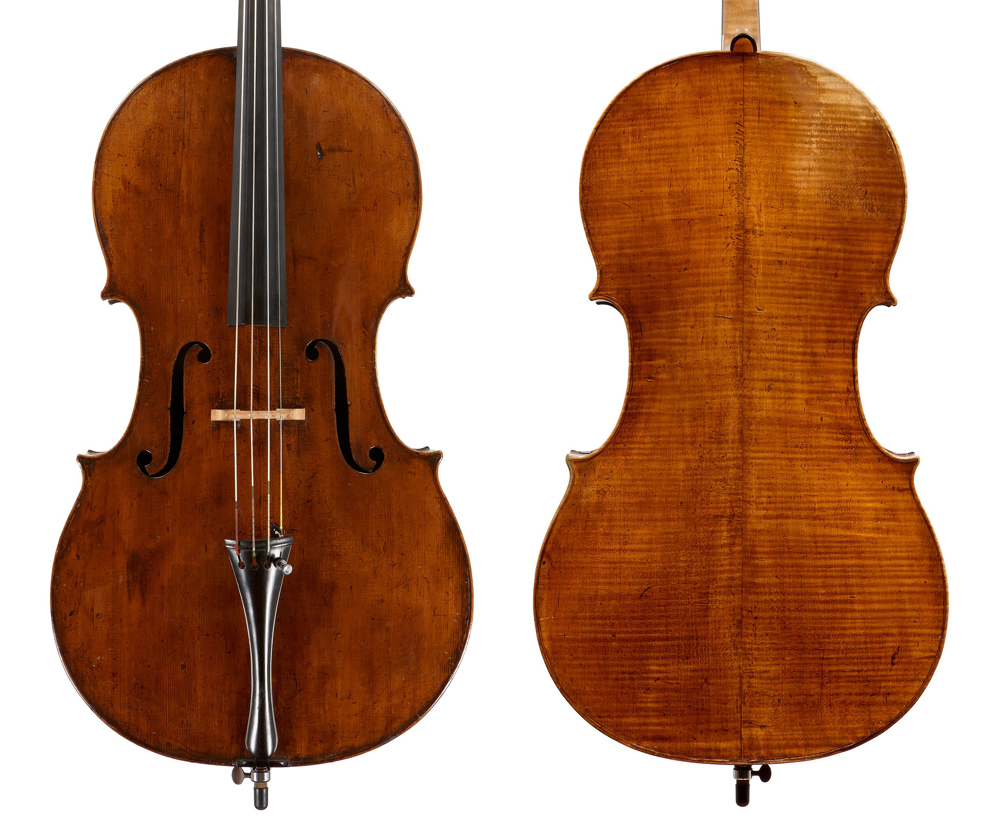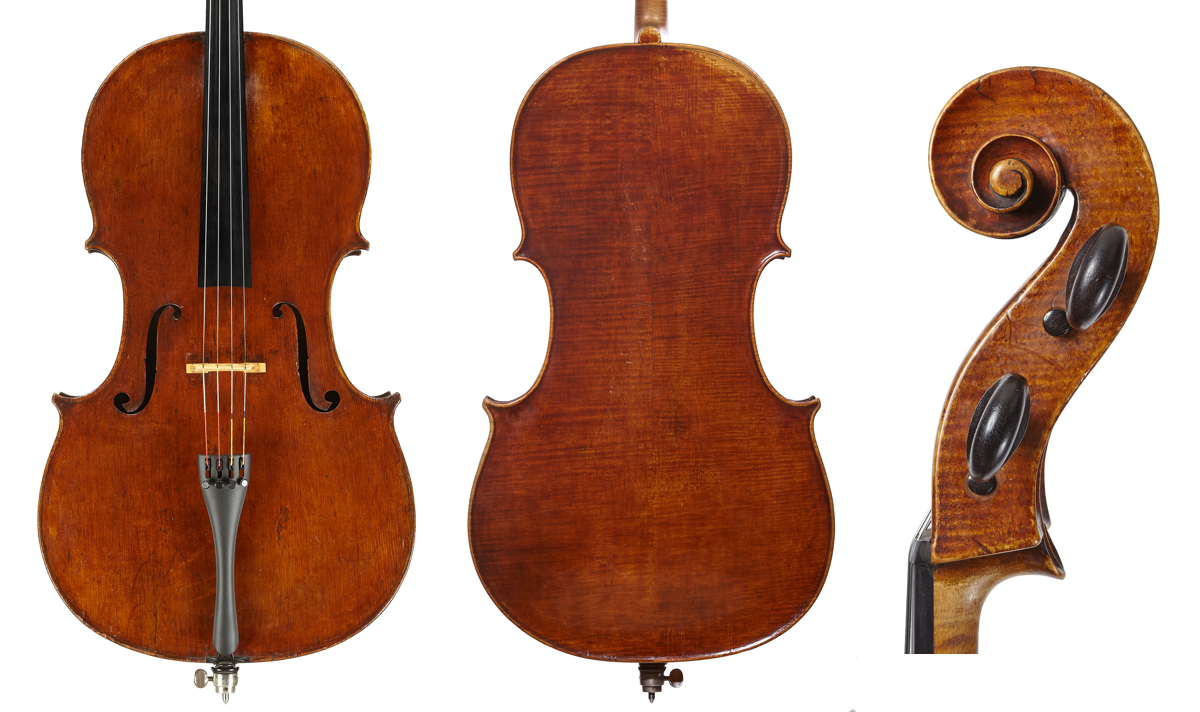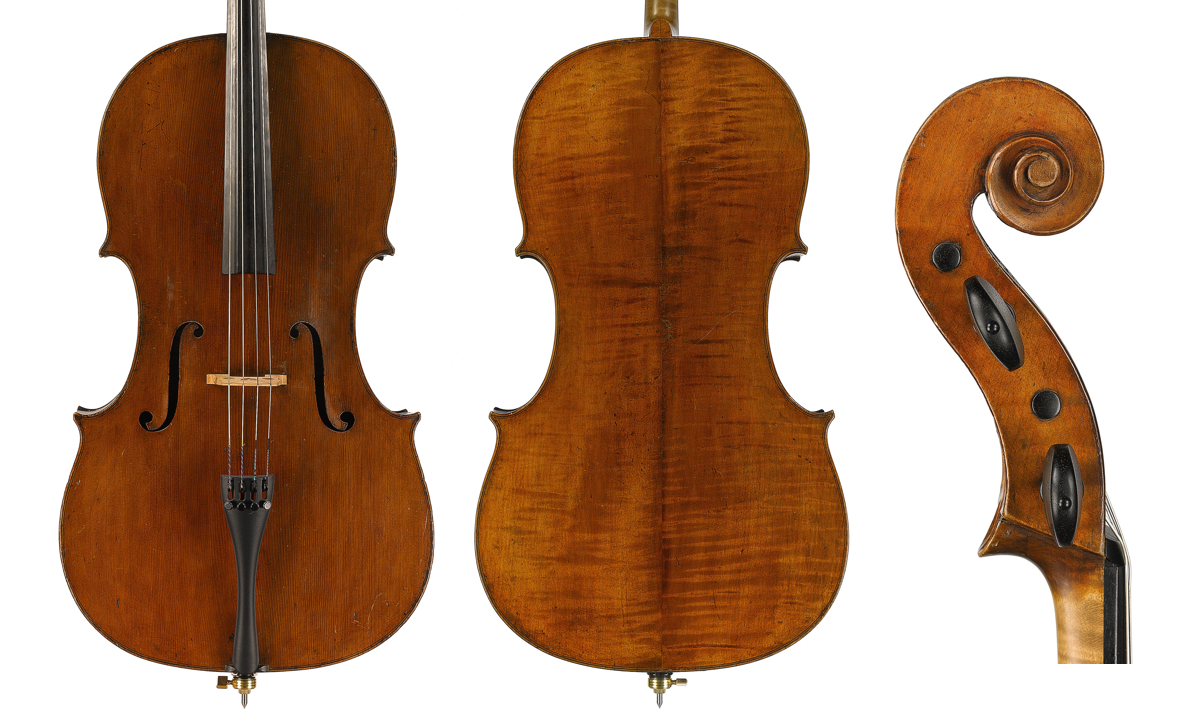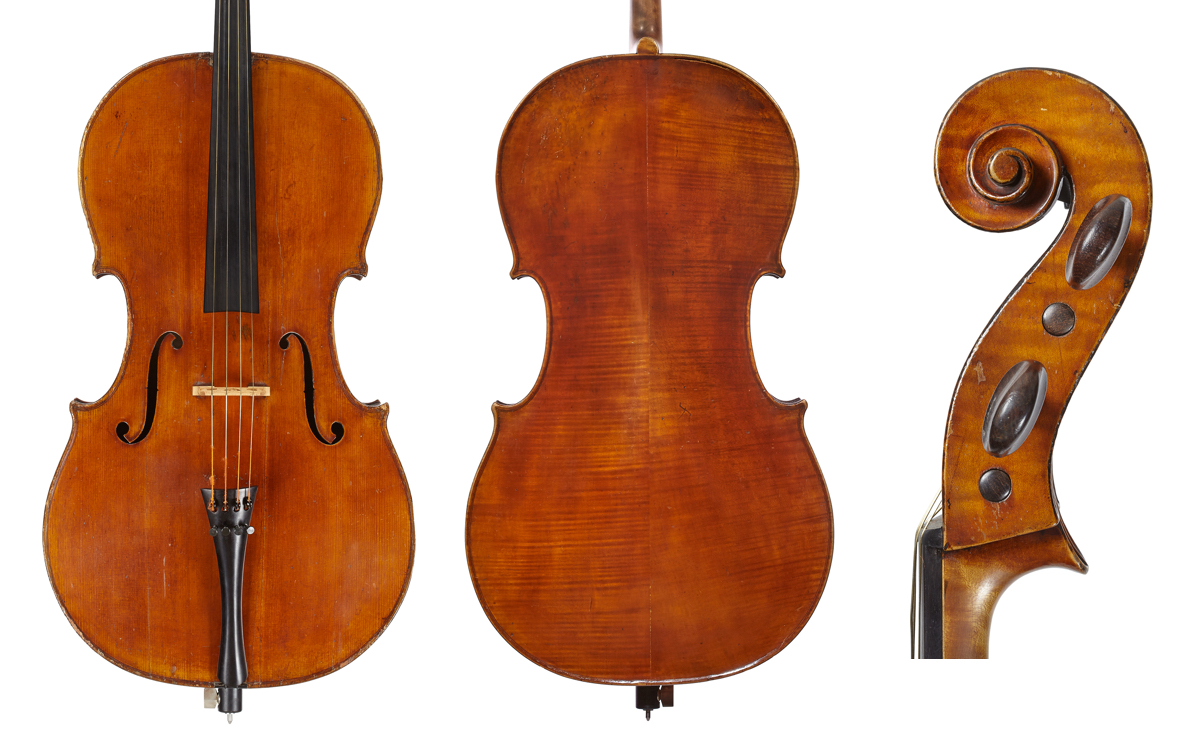The first maker to take advantage of the new fashion for the cello in England (see part 1) was probably Peter Wamsley, working from around 1720 in Piccadilly, London. His model was deeply influenced by the Stainer violins that most English players and musical patrons aspired to. Actual Stainer cellos are very rare, but it is quite possible that Wamsley was familiar with a particular example. The key point, however, is that Wamsley’s instruments were from the beginning made to the 29 ½” (around 75 cm) back length that has since become standard, so that his instruments, and those of the great array of English cello makers that followed him, are available to modern players with the minimum of adjustment. This ‘compromise’ form was still new even in Italy. Stradivari had introduced his own ‘forma B’ to these general proportions in around 1707, but many other makers were slow to adapt.
It is startling to realise that during the 18th century there were easily more than a hundred premises scattered around London in which professional violin and cello making was practised. The larger ones employed several craftsmen, and businesses often passed from father to son over several generations. There are certainly several hundred individuals known through their own labeled instruments and many more are constantly being revealed through their signatures buried within the instruments made for other masters. This was a major activity of the city, and by the mid-18th century much of their energy was devoted to making the newly fashionable cello.
Wamsley’s son took over his business, which then passed to Thomas Smith, while from 1743 the Thompson family, Robert, Peter, Samuel and Charles, established themselves in St Paul’s Churchyard and were, to judge by the numbers that survive, managing extensive shops producing modest but effective Stainer-modeled instruments, relying on mostly anonymous suppliers working to very consistent standards. The Hills, when considering their ancestor Joseph (1715–1784), whose workshop in 1765 was adjacent to the Haymarket Theatre where Haydn and Giardini played, decided that there were literally too many of his cellos around to be the work of one man. They speculate that Thomas Tilley was one assistant, but there may have been others. Joseph, making very fine Stainer-modeled instruments, was the most significant cello maker of the period. His son Lockey Hill (1756–1810) was one of the many craftsmen who sent numbers of robustly made but characterful instruments for sale through agents Longman & Broderip (active from around 1767–1790). Richard Duke and Jacob Ford are a little unusual in that their cellos are rare, but John Johnson and the second Henry Jay (unrelated to the earlier viol maker as far as is known) made up for their lack.
William Forster (1739–1808), arriving in London from Cumbria in 1759, helpfully kept accounts of his activity which were published by his grandson Simon Andrew Forster in 1864. [1] They provide a fascinating glimpse into his business. Cervetto, Lindley and Crosdill were all customers of his. In the 1784 accounts, among the instruments recorded as made in Forster’s shop there are seven cellos, in 1785 eleven and in 1786 eleven more, all to meet orders from around the country. In the same years he made six, thirteen and twelve violins, a striking balance that would seem strange to modern makers, and a real contrast with other continental makers of the period. In 1782 he made the famous ‘Royal Forster’, one of two cellos he made for George Frederick, Prince of Wales (son of George III and nephew of the Frederick mentioned in part 1, the cellist of the Mercier portrait), this being emblazoned with the prince’s coat of arms – another strong indication of the fashion for the cello in London in this period. Forster added the appointments ‘to their Royal Highnesses the Prince of Wales and the Duke of Cumberland’ to his labels. He employed several fine cello builders, including Samuel Gilkes, John Morrison and Thomas Kennedy.
During the same period Benjamin Banks was very active in Salisbury, making a similarly equal output of violins and cellos, as it would appear from his surviving work. These were also based on variations of the Amati and Stainer model, with a deep red varnish comparable to Forster’s. Both Forster and Banks worked to generally high standards of craftsmanship and detail, but also provided plainer instruments, presumably at lower prices. As the Forster accounts show, these cellos were being despatched all around the country, and Banks’ Salisbury-made instruments were also sold by agents in London. Other provincial makers and dealers often put their labels in them, but Mark Dearlove of Leeds (1770–1820) was typical of a number of other makers outside London whose fine, sometimes naively decorated instruments are a distinctive part of the 18th- and 19th-century British cello school. The chosen model was now beginning to change, as Simon Andrew Forster notes: ‘the Steiner (sic) pattern… adopted by William Forster [senior] in 1762’, but ‘about ten years afterward, the Amati outline was employed.’ [2] Both Banks and Forster took up models that were only in the loosest sense ‘Amatese’, as original examples in the shorter form did not exist.
Around the corner from Forster in Oxford Street, his former assistant Thomas Kennedy was similarly in a spate of production. He came from a family that worked for various shops including that of John Johnson, and his output was prodigious and varied. There are instruments of distinguished finish and workmanship, and others poor in materials and execution, clearly made to a minimum standard for casual sale. Kennedy himself employed makers of the London trade, notably James Brown, and it is intriguing to think of the workshop churning out quantities of cellos in the center of London; the throughput of materials and the space required to do the work, in the crowded streets of the city, already at that time home for three-quarters of a million people.
Kennedy was one of the main exponents of the ‘Amati’ model referred to by Forster. It is interesting in that it is clearly copied from a large 17th-century Amati cello that had been cut down, leaving the center bouts at their original length and shape, but the upper and lower bouts very much shortened. This strangely proportioned model is one of the characteristic forms of 18th and early 19th century English cellos.
The eventual change from the Amati to the Stradivari model is largely due to another of the great 18th-century makers and businessmen, John Betts, who in many ways can be considered the English Vuillaume. Like many other London makers he was an incomer, from Stamford in Lincolnshire. He worked for Duke initially but eventually settled in fine premises at the Royal Exchange in the heart of the City of London. He too garnered aristocratic patronage and built many superb cellos on a loosely Stradivarian model. His importance is now associated with the workshop of the early-19th century continued by his heirs, but home to the very best makers of the time, the Fendts, Lockey Hill and of course Vincenzo Panormo. They led a revolution in English making, finally committing to the Stradivari model and making many fine replicas.
At least a dozen of the finest Stradivari cellos all passed through the Betts shop
The company that John Betts founded remained in business until 1867 and in that time at least a dozen of the finest Stradivari cellos, including the 1684 ‘General Kyd’ and ‘Visconti’, c.1688 ‘Marylebone’, 1696 ‘Aylesford’, 1698 ‘Cholmondeley’, 1711 ‘Mara’, 1717 ‘Fleming, Spanish Bass’, 1720 ‘Piatti’, 1724 ‘Hausmann’ and 1728 ‘Romberg’ all passed through the Betts shop. All these provided valuable patterns for the great cellos made by Lockey Hill and the Fendts. According to the Hills themselves [3] Lockey Hill took his personal templates from a Stradivari dated 1690 belonging to the King of Prussia, which was in Betts’ shop, and this probably refers to the large form ‘Marylebone’ which was probably reduced in size in the Betts shop. The first intact ‘forma B’ Strad seen was probably the ‘Mara’ played by Johann Baptist Mara of Berlin, who was resident in London from 1784–1802. This was bought from him by John Crosdil. Equally important were the instruments made in some quantities by the less well-known employees at Betts: the Furbers, John Carter, William Taylor and several others, all adding vigorously to the stock of well-proportioned and versatile English cellos.
A rival to Betts was Thomas Dodd, established in Covent Garden from 1794. The business lasted until about 1840, employing Bernard Simon Fendt and John Lott among others in the general London trade, and an impressive number of fine Stradivari-modeled cellos bear the shop’s label.
It is probably fair to say that by the middle of the 19th century this remarkable focus on the cello by British makers was on the wane. W.E. Hill & Sons themselves produced remarkably few, although Edward Withers retained a great enthusiasm for the instrument, being a professional cellist himself before establishing his shop in Haymarket. One of his first actions as a violin dealer was the sale of the 1698 ‘Cholmondeley’ Stradivari cello previously handled by Betts, and in his employment Charles Boullangier (1823–1888) made some remarkable ‘del Gesu’-influenced models. English cellos continued to be made, but the flood of the 18th century was reduced to production of more familiar proportions alongside the violins and violas.
The social, historical and musical fashions that triggered the production of so many British cellos are presumably many and complex. The instrument was undoubtedly popular among amateurs as well as the burgeoning class of professional orchestral players and soloists. But what seems a significant factor was the traditional village or church band.
The Village Choir gives a perfect image of the rural church, before the installation of an organ, with a slightly grumpy-looking cellist in the corner
Anthony Trollope’s The Warden, published in 1855, has as its central character the admirable but put-upon Septimus Harding, who consoles himself by playing his cello, largely choosing hymn tunes and simple melodies rather than the challenges of classical repertoire. The often-reproduced painting The Village Choir by Thomas Webster from about 1847 gives a perfect image of the rural church, before the installation of an organ (also the subject of Thomas Hardy’s Under the Greenwood Tree, written in 1872) with a slightly grumpy-looking cellist in the corner. Church bands up and down the country seem to have been dependent on the cello as a bass instrument until the widespread adoption of organs in the later 19th century.
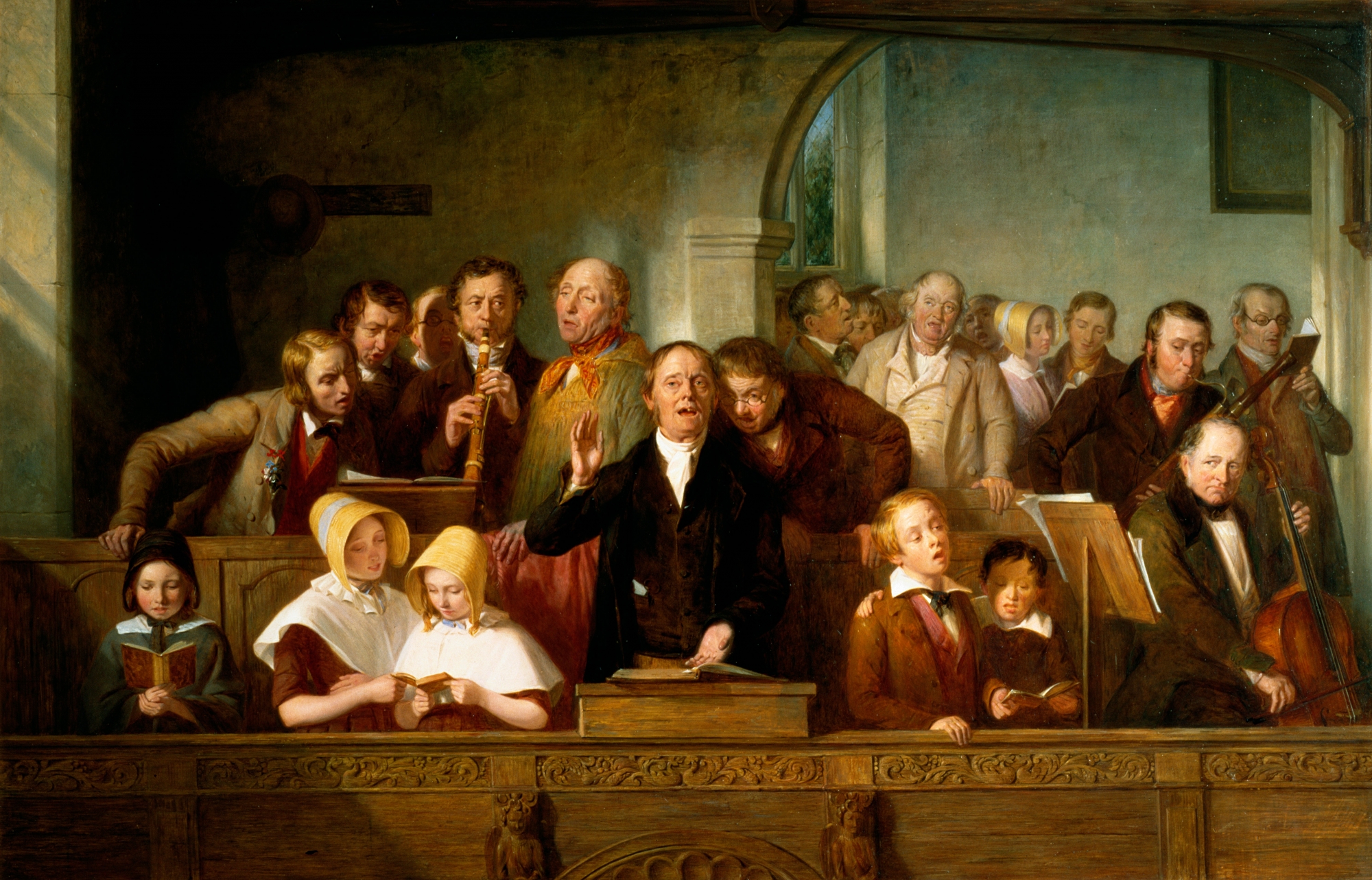
The Village Choir, painted by Thomas Webster in 1847
During the heyday of British cello making, much of the demand may therefore have come from rural parishes where the cello provided the bass accompaniment to the choir and the village band. There are a number of parish priests in Forster’s order book, but it is also true that ecumenicals in the 19th century enjoyed high status and many dabbled in high-end violin and cello collecting: the reverends Willan, Blow and Coppard were owners of distinguished Stradivari instruments in this same period. Nevertheless, there is an interesting parallel in the development of violin making in the US, at the forefront of which in the early 1800s was Abraham Prescott, whose renowned ‘church bass’ cellos and double basses made up virtually his entire output and were specifically designed for use in the newly built churches of New England.
At the other end of the scale, the professional players from Cervetto, Crosdill and Lindley onwards have had the stronger influence, naturally, in enabling the best and most ambitious makers to produce work of the highest quality, which can compete today with all but the very finest 17th- and 18th-century Italian work. These two distinct roles for the British cello helps to explain why many of the makers produced instruments both of cheaper quality and of more refined and expensive workmanship. The result is that craftsmen of the British Isles at all levels have provided more than their fair share of cellos, sometimes ruggedly useful, but just as often highly distinguished and prestigious, to the benefit of players the world over.
John Dilworth is a maker, writer and expert. He has written extensively about fine instruments and their makers, and is a co-author of ‘The British Violin’, ‘Giuseppe Guarneri del Gesu’ and ‘The Voller Brothers’ among other books.
Notes
[1] William Sandys and Simon Andrew Forster, The History of the Violin, Reeves, London 1864.
[2] Sandys and Forster, Op. cit.
[3] W.H., A.F. and A.E. Hill, Antonio Stradivari, his Life and Work, London 1902, p.126.
See also The British Violin, BVMA 2000.
